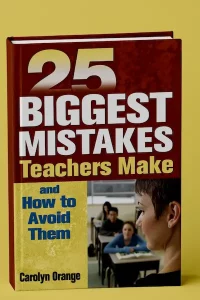All teachers make mistakes, but when those missteps involve students, they can have negative effects for years to come. This second edition of the bestseller by Carolyn Orange offers reflective scenarios and insights to help teachers learn from examples of undesirable teaching techniques and find better ways to address challenging or stressful classroom situations.
25 Biggest Mistakes Teachers Make and How to Avoid Them, Second Edition, includes newly updated scenarios containing real student voices and teacher vignettes, as well as the author’s prescriptions for better solutions. Drawn from many years of teaching experience, each prescription is aligned with sound educational theory and provides a dash of humor to help the solution stick. The book is organized into six sections, covering:
• Discipline
• Teacher-student relations
• Classroom policy and practices
• Classroom management and instruction
• Personality and professionalism
• Teaching style and behavior
Excellent for staff development workshops and seminars, preservice and inservice teachers, and teacher leaders and mentors, this book’s real-life examples offer valuable professional lessons while helping teachers better understand the responses and feelings of their students.
25 Biggest Mistakes Teachers Make and How to Avoid Them
The first edition of 25 Biggest Mistakes Teachers Make and How to Avoid Them has been a bestseller for a number of years and has been translated into three languages, Thai, Chinese, and Slovenian. It has been reviewed in India, used in a school of midwifery in Ireland, and in numerous other contexts in many states in the United States and several countries such as Ireland, Romania, India, France, China, United Kingdom, Japan, and others.
Book Content
Twenty-five categories of mistakes were identified and organized into the first six chapters. Chapter 7 explores teachers’ self- report of their worst treatment of a student. Commentary on the teachers’ actions and behaviors is included.
Chapter 1, Discipline, focuses on the unacceptable or inappropriate methods that some teachers resorted to when trying to control their students. There were different variations of physical aggression, alienation, and ridicule.
Chapter 2, Teacher—Student Relations, examines interpersonal rela- tions that involved favoritism, discrimination, personal attacks, mistreat- ment, humiliation, and inappropriate relations.
Chapter 3, Classroom Policies and Practices, looks at classroom policies and toileting practices.
Chapter 4, Classroom Management and Instruction, details the employment of a variety of inappropriate educational strategies and assessments.
Chapter 5, Personality and Professionalism, explores personal areas such as teacher insensitivity and academic shortcomings. It also includes professional areas such as poor organization and administration, reputation, and other blatant errors.
Chapter 6, Teaching Style and Behavior, investigates teacher bias, unethical behavior, false accusations, sexual harassment, and other inappropriate reactions.
Chapter 7, Teacher Confessions of Worst Treatment of a Child, offers a rationale and explanation of teachers’ mistreatment of students. Including the teachers’ self-report of their actions, perceptions, and motives gives credence to the students’ self-reporting of their worst experience with a teacher in the previous sections of this book.
A motive probe in the form of questions and answers is included for each of the 44 worst treatment scenarios. Some critical commentary is offered for each scenario.
The benefit of this chapter is that it offers some illumination and understanding of why certain teacher behaviors occurred in the scenarios in previous sections. This chapter concludes with some suggested ways to avoid making the 25 biggest mistakes teachers make.


